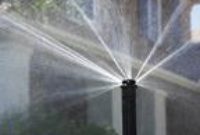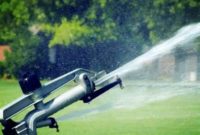When you’re choosing a sprinkler or irrigation system, consider selecting one that sends large drops of water close to the ground. These sprinklers are more water-efficient than sprinklers that spray a fine mist and lose a lot of water through evaporation. Drip irrigation is a great alternative for trees, shrubs, perennials and groundcovers. Little or no water is lost to evaporation as the water is applied at ground level, near plant roots.

A well-planned watering system can help you avoid over watering, which not only wastes water but can be harmful to your plants. Knowing how much water your plants need, and periodically monitoring and maintaining your irrigation system are the keys to saving both water and money.
- Soaker Hoses – Most gardeners are familiar with soaker hoses, which sweat water along their entire length. Soaker hoses can be used to thoroughly water dense plantings or individual plants. You can also customize a watering system to your garden by attaching soaker hoses to solid hoses. This way, you avoid wasting water in areas that do not need it.

- Drip System – Drip irrigation is the most water-efficient way to irrigate many different plantings. It is an ideal way to water in clay soils because the water is applied slowly, allowing the soil to absorb the water and avoid runoff. Drip devices use a fraction of the water that overhead spray devices use. “Point source” drip systems are comprised of drip tubing that is laid throughout a planting bed and feeds water directly to the base of the plants at a rate the soil can absorb without losing water to misting, overspray, or runoff.
There are many different types of drip equipment, including drippers, bubblers, soakers (inline emitters), and micro-sprayers. Drip systems can be customized to meet each plant’s needs. However, you should not mix different equipment in the same zone or distribution line, if possible. In other words, you wouldn’t put inline emitter pipe in the same zone with bubblers. Use separate zones for each type of equipment.
The discharge rate of drip emitters varies from one-half gallon per hour to two gallons per hour and depends on the plant and its size, as well as the soil type. Micro-sprayers use much more water — up to 15 gallons per hour, but still much less than above-ground sprinklers. Generally, you will need at least one emitter device for every two-and-a-half feet of plant canopy.
- Traditional Automatic Spray System – Among traditional automatic spray systems are pop-up spray heads that can be adjusted to spray a full circle, half circle or quarter circle. The disadvantage of spray heads is that they are often less efficient than rotor heads or drip systems, because they put water down on the ground faster than our clay soil can absorb it.
Whatever heads you use, you want to make sure they are spaced so that each head sprays to the next head, or what is called “head-to-head” coverage. All heads should be of the same type and by the same manufacturer to get uniform distribution of water.
- Rotor System – Rotor systems are generally more efficient than spray heads. They apply water at a much slower rate than spray heads, allowing the soil to absorb moisture more efficiently. In the past, rotors haven’t been used for smaller turf areas, but there are new rotors specifically designed to apply water at less than half-an-inch per hour, and with a radius of less than 15 feet. Application patterns and radius are adjustable, which can conform to odd-shaped areas.
